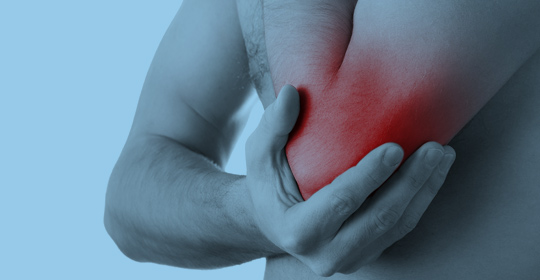
02 May Elbow Pain
The two most common soft tissue injuries to the elbow are medial and lateral epicondylitis, aka Golfers and Tennis Elbow respectively. Are these the only injuries to the elbow? No, but the majority of cases fall into these categories and that is why we will discuss them in this article. Both of these conditions can be acute or chronic in nature, resulting in a few weeks of pain or years of nagging frustration. Patients normally maintain full elbow range of motion, X-rays are normal, and have less pain in the morning and at rest. Symptoms include pain with grasping, stiffness, mild weakness, and can affect daily functions like using utensils, opening doors and jars, shaking hands, and playing sports. Some people will even have to change job roles due to inability to function at full capacity.
Medial epicondylitis is pain over the INSIDE elbow that usually occurs due to repetitive micro trauma such as excessive twisting and straining of the forearm. The muscles that flex the wrist and hand attach to the inner (medial) elbow are the tissues that become injured, inflamed or even torn. This condition is also called Golfers elbow, Pitchers elbow, or Little League elbow due to stress that these sports put on the medial elbow. Other common activities that create this condition are climbing, racquet sports, and weight lifters (especially bench press and biceps curls). If problematic enough this condition can create some numbness and tingling into the pinky and ring fingers by compressing the ulnar nerve.
Lateral epicondylitis is pain over the OUTSIDE elbow that is injured similarly. The muscles that extend the wrist and hand attach to the outer (lateral) elbow and these are the tissues that are compromised. This condition is also called Tennis elbow and is 5 times more common then medial epicondylitis. It is common in manual workers such as builders, mechanics, waiters, painters, those in an assembly line, and even desk workers. A long day of landscaping, shoveling, typing, vacuuming, and many more can flare this condition.
Here at Health in Balance our approach is to reduce, restore, and relearn. Reduce the pain and inflammation through Laser therapy, e-stim, home utilization of ice and Traumeel (homeopathic ointment). Restore normal soft tissue function by incorporating Graston Technique to correct scar tissue and myofascial restrictions followed by simple rehab that can be done at home. Finally relearn how to prevent this from occurring or to at least reduce frequency of events. This is established by assessing your biomechanics in your daily life and at play. Fix your form, have your clubs or racquet sized to fit you, warm up, cool down, stretch, and learn when to stop and rest. At work your station needs to be assessed for proper ergonomics, maintain proper posture of your spine, elbow and wrist, and proper desk height.
Medial and lateral epicondylitis are very responsive to conservative management, set up a time to regain your health. And yes, tennis players can get Golfer’s elbow and golfers can get Tennis elbow. Thank you very much for your time and stay healthy.




Sorry, the comment form is closed at this time.